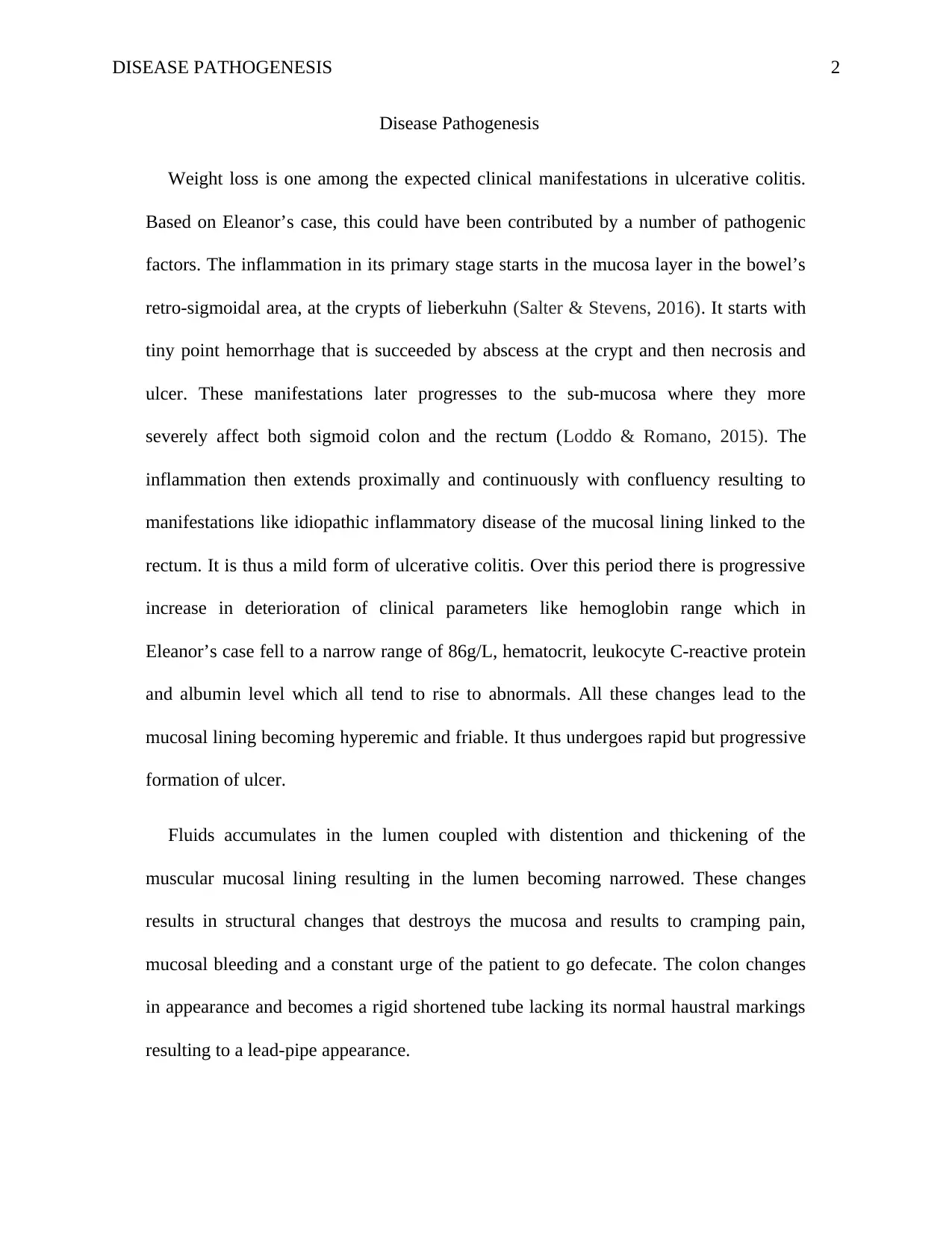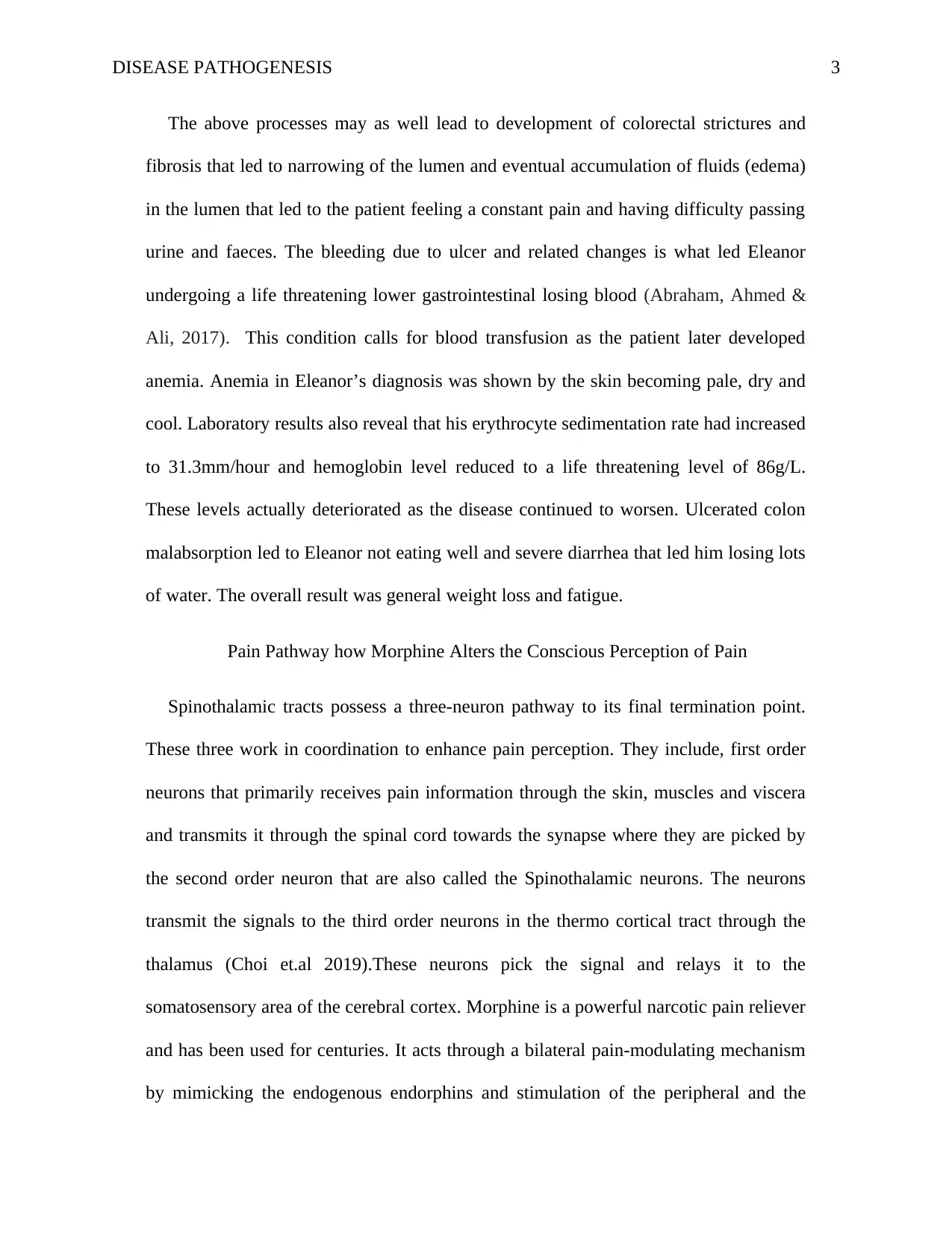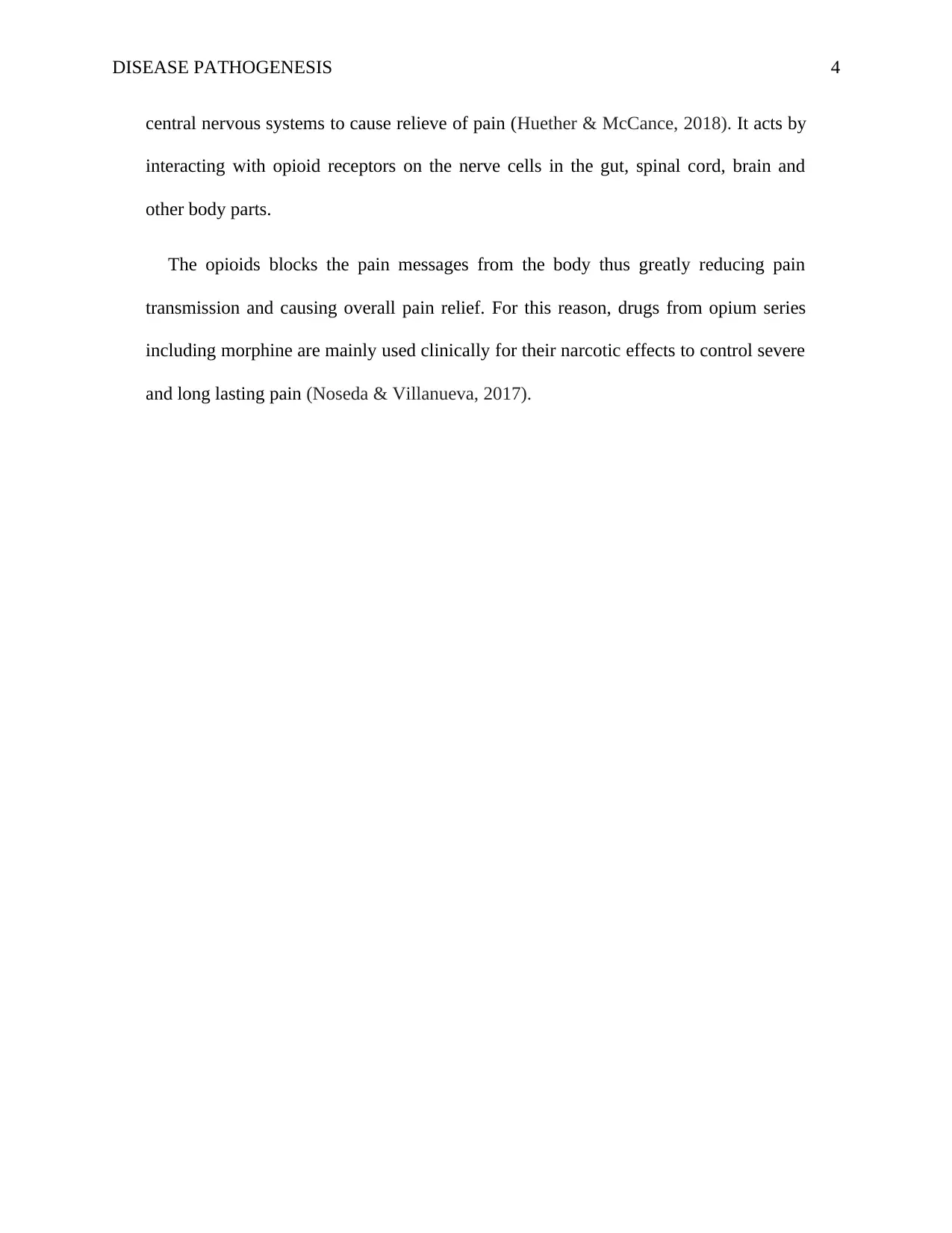Disease Pathogenesis Case Study: Eleanor Brown's Ulcerative Colitis
VerifiedAdded on 2023/01/10
|5
|955
|21
Case Study
AI Summary
This case study focuses on Eleanor Brown, a patient with ulcerative colitis, and explores the disease's pathogenesis. The analysis begins with the initial inflammation in the mucosa layer and progresses to the sub-mucosa, leading to ulcer formation, bleeding, and structural changes in the colon. The case highlights the clinical manifestations such as weight loss, fatigue, and abdominal pain. The study also delves into the pain pathway, explaining how morphine alters the conscious perception of pain by interacting with opioid receptors. References to recent studies on the disease and morphine are included to support the analysis. The case study provides insights into the mechanisms and effects of the disease as well as its management through medication.

Running head: DISEASE PATHOGENESIS 1
Disease Pathogenesis Case Study
Student’s Name
Institution’s Affiliations
Date
Disease Pathogenesis Case Study
Student’s Name
Institution’s Affiliations
Date
Paraphrase This Document
Need a fresh take? Get an instant paraphrase of this document with our AI Paraphraser

DISEASE PATHOGENESIS 2
Disease Pathogenesis
Weight loss is one among the expected clinical manifestations in ulcerative colitis.
Based on Eleanor’s case, this could have been contributed by a number of pathogenic
factors. The inflammation in its primary stage starts in the mucosa layer in the bowel’s
retro-sigmoidal area, at the crypts of lieberkuhn (Salter & Stevens, 2016). It starts with
tiny point hemorrhage that is succeeded by abscess at the crypt and then necrosis and
ulcer. These manifestations later progresses to the sub-mucosa where they more
severely affect both sigmoid colon and the rectum (Loddo & Romano, 2015). The
inflammation then extends proximally and continuously with confluency resulting to
manifestations like idiopathic inflammatory disease of the mucosal lining linked to the
rectum. It is thus a mild form of ulcerative colitis. Over this period there is progressive
increase in deterioration of clinical parameters like hemoglobin range which in
Eleanor’s case fell to a narrow range of 86g/L, hematocrit, leukocyte C-reactive protein
and albumin level which all tend to rise to abnormals. All these changes lead to the
mucosal lining becoming hyperemic and friable. It thus undergoes rapid but progressive
formation of ulcer.
Fluids accumulates in the lumen coupled with distention and thickening of the
muscular mucosal lining resulting in the lumen becoming narrowed. These changes
results in structural changes that destroys the mucosa and results to cramping pain,
mucosal bleeding and a constant urge of the patient to go defecate. The colon changes
in appearance and becomes a rigid shortened tube lacking its normal haustral markings
resulting to a lead-pipe appearance.
Disease Pathogenesis
Weight loss is one among the expected clinical manifestations in ulcerative colitis.
Based on Eleanor’s case, this could have been contributed by a number of pathogenic
factors. The inflammation in its primary stage starts in the mucosa layer in the bowel’s
retro-sigmoidal area, at the crypts of lieberkuhn (Salter & Stevens, 2016). It starts with
tiny point hemorrhage that is succeeded by abscess at the crypt and then necrosis and
ulcer. These manifestations later progresses to the sub-mucosa where they more
severely affect both sigmoid colon and the rectum (Loddo & Romano, 2015). The
inflammation then extends proximally and continuously with confluency resulting to
manifestations like idiopathic inflammatory disease of the mucosal lining linked to the
rectum. It is thus a mild form of ulcerative colitis. Over this period there is progressive
increase in deterioration of clinical parameters like hemoglobin range which in
Eleanor’s case fell to a narrow range of 86g/L, hematocrit, leukocyte C-reactive protein
and albumin level which all tend to rise to abnormals. All these changes lead to the
mucosal lining becoming hyperemic and friable. It thus undergoes rapid but progressive
formation of ulcer.
Fluids accumulates in the lumen coupled with distention and thickening of the
muscular mucosal lining resulting in the lumen becoming narrowed. These changes
results in structural changes that destroys the mucosa and results to cramping pain,
mucosal bleeding and a constant urge of the patient to go defecate. The colon changes
in appearance and becomes a rigid shortened tube lacking its normal haustral markings
resulting to a lead-pipe appearance.

DISEASE PATHOGENESIS 3
The above processes may as well lead to development of colorectal strictures and
fibrosis that led to narrowing of the lumen and eventual accumulation of fluids (edema)
in the lumen that led to the patient feeling a constant pain and having difficulty passing
urine and faeces. The bleeding due to ulcer and related changes is what led Eleanor
undergoing a life threatening lower gastrointestinal losing blood (Abraham, Ahmed &
Ali, 2017). This condition calls for blood transfusion as the patient later developed
anemia. Anemia in Eleanor’s diagnosis was shown by the skin becoming pale, dry and
cool. Laboratory results also reveal that his erythrocyte sedimentation rate had increased
to 31.3mm/hour and hemoglobin level reduced to a life threatening level of 86g/L.
These levels actually deteriorated as the disease continued to worsen. Ulcerated colon
malabsorption led to Eleanor not eating well and severe diarrhea that led him losing lots
of water. The overall result was general weight loss and fatigue.
Pain Pathway how Morphine Alters the Conscious Perception of Pain
Spinothalamic tracts possess a three-neuron pathway to its final termination point.
These three work in coordination to enhance pain perception. They include, first order
neurons that primarily receives pain information through the skin, muscles and viscera
and transmits it through the spinal cord towards the synapse where they are picked by
the second order neuron that are also called the Spinothalamic neurons. The neurons
transmit the signals to the third order neurons in the thermo cortical tract through the
thalamus (Choi et.al 2019).These neurons pick the signal and relays it to the
somatosensory area of the cerebral cortex. Morphine is a powerful narcotic pain reliever
and has been used for centuries. It acts through a bilateral pain-modulating mechanism
by mimicking the endogenous endorphins and stimulation of the peripheral and the
The above processes may as well lead to development of colorectal strictures and
fibrosis that led to narrowing of the lumen and eventual accumulation of fluids (edema)
in the lumen that led to the patient feeling a constant pain and having difficulty passing
urine and faeces. The bleeding due to ulcer and related changes is what led Eleanor
undergoing a life threatening lower gastrointestinal losing blood (Abraham, Ahmed &
Ali, 2017). This condition calls for blood transfusion as the patient later developed
anemia. Anemia in Eleanor’s diagnosis was shown by the skin becoming pale, dry and
cool. Laboratory results also reveal that his erythrocyte sedimentation rate had increased
to 31.3mm/hour and hemoglobin level reduced to a life threatening level of 86g/L.
These levels actually deteriorated as the disease continued to worsen. Ulcerated colon
malabsorption led to Eleanor not eating well and severe diarrhea that led him losing lots
of water. The overall result was general weight loss and fatigue.
Pain Pathway how Morphine Alters the Conscious Perception of Pain
Spinothalamic tracts possess a three-neuron pathway to its final termination point.
These three work in coordination to enhance pain perception. They include, first order
neurons that primarily receives pain information through the skin, muscles and viscera
and transmits it through the spinal cord towards the synapse where they are picked by
the second order neuron that are also called the Spinothalamic neurons. The neurons
transmit the signals to the third order neurons in the thermo cortical tract through the
thalamus (Choi et.al 2019).These neurons pick the signal and relays it to the
somatosensory area of the cerebral cortex. Morphine is a powerful narcotic pain reliever
and has been used for centuries. It acts through a bilateral pain-modulating mechanism
by mimicking the endogenous endorphins and stimulation of the peripheral and the
⊘ This is a preview!⊘
Do you want full access?
Subscribe today to unlock all pages.

Trusted by 1+ million students worldwide

DISEASE PATHOGENESIS 4
central nervous systems to cause relieve of pain (Huether & McCance, 2018). It acts by
interacting with opioid receptors on the nerve cells in the gut, spinal cord, brain and
other body parts.
The opioids blocks the pain messages from the body thus greatly reducing pain
transmission and causing overall pain relief. For this reason, drugs from opium series
including morphine are mainly used clinically for their narcotic effects to control severe
and long lasting pain (Noseda & Villanueva, 2017).
central nervous systems to cause relieve of pain (Huether & McCance, 2018). It acts by
interacting with opioid receptors on the nerve cells in the gut, spinal cord, brain and
other body parts.
The opioids blocks the pain messages from the body thus greatly reducing pain
transmission and causing overall pain relief. For this reason, drugs from opium series
including morphine are mainly used clinically for their narcotic effects to control severe
and long lasting pain (Noseda & Villanueva, 2017).
Paraphrase This Document
Need a fresh take? Get an instant paraphrase of this document with our AI Paraphraser

DISEASE PATHOGENESIS 5
References
Loddo, I., & Romano, C. (2015). Inflammatory bowel disease: genetics, epigenetics,
and pathogenesis. Frontiers in immunology, 6, 551.
Huether, S. E., & McCance, K. L. (2018). Pathophysiology: The biologic basis for
disease in adults and children. Elsevier Health Sciences.
Abraham, B. P., Ahmed, T., & Ali, T. (2017). Inflammatory bowel disease:
pathophysiology and current therapeutic approaches. In Gastrointestinal
Pharmacology (pp. 115-146). Springer, Cham.
Choi, D. B. ., Fridley, J. S., Gokaslan, Z. L Groh, Nam, G, D. M., Syed, S. (2019).
Spinal Cord Anatomy. In Spinal Cord Tumors (pp. 43-53). Springer, Cham.
Noseda, R., & Villanueva, L. (2017). Functional Architecture of Central Pain Pathways:
Focus on the Trigeminovascular System. Neurobiological Basis of Migraine,
69-90.
Salter, M. W., & Stevens, B. (2017). Microglia emerge as central players in brain
disease. Nature medicine, 23(9), 1018.
References
Loddo, I., & Romano, C. (2015). Inflammatory bowel disease: genetics, epigenetics,
and pathogenesis. Frontiers in immunology, 6, 551.
Huether, S. E., & McCance, K. L. (2018). Pathophysiology: The biologic basis for
disease in adults and children. Elsevier Health Sciences.
Abraham, B. P., Ahmed, T., & Ali, T. (2017). Inflammatory bowel disease:
pathophysiology and current therapeutic approaches. In Gastrointestinal
Pharmacology (pp. 115-146). Springer, Cham.
Choi, D. B. ., Fridley, J. S., Gokaslan, Z. L Groh, Nam, G, D. M., Syed, S. (2019).
Spinal Cord Anatomy. In Spinal Cord Tumors (pp. 43-53). Springer, Cham.
Noseda, R., & Villanueva, L. (2017). Functional Architecture of Central Pain Pathways:
Focus on the Trigeminovascular System. Neurobiological Basis of Migraine,
69-90.
Salter, M. W., & Stevens, B. (2017). Microglia emerge as central players in brain
disease. Nature medicine, 23(9), 1018.
1 out of 5
Related Documents
Your All-in-One AI-Powered Toolkit for Academic Success.
+13062052269
info@desklib.com
Available 24*7 on WhatsApp / Email
![[object Object]](/_next/static/media/star-bottom.7253800d.svg)
Unlock your academic potential
Copyright © 2020–2025 A2Z Services. All Rights Reserved. Developed and managed by ZUCOL.




